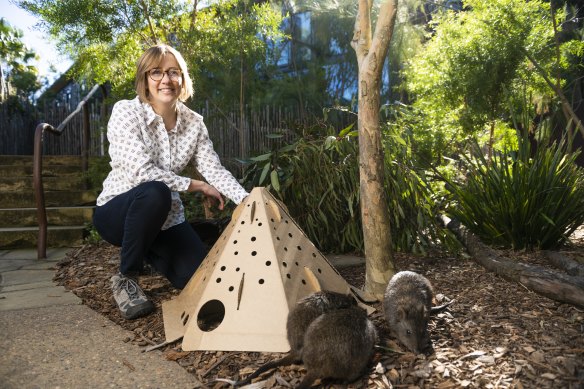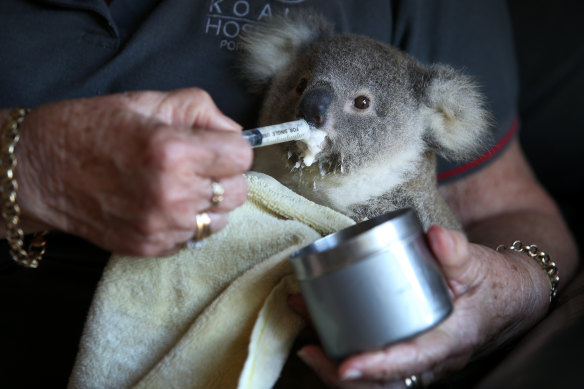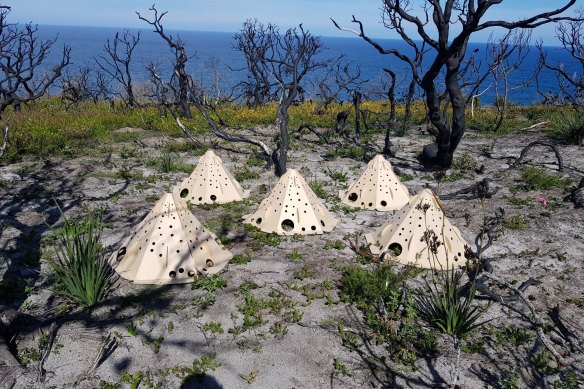Cardboard ‘rocketships’: How NSW plans to prevent another billion wildlife deaths
By Laura Chung and Angus Dalton
Biodegradable flat-pack habitat pods that resemble cardboard rocketships, specialist emergency squads and 80,000 firefighters briefed in wildlife care are joining NSW’s preparations for the next bushfire season after three billion animals were killed or injured during Black Summer.
As she watched images of the fires’ aftermath, conservation ecologist Dr Alexandra Carthey – like many – knew she wanted to do something to help.

A biodegradable pop-up pod could be key to helping maintain healthy animal populations post-bushfires.Credit: Rhett Wyman
Populations of invasive species including cats and foxes boom following droughts, floods and fire. These disasters allow such species to spread to new habitats and prey on vulnerable native animals in scorched fire grounds.
After years of design work, Carthey created pop-up biodegradable shelters that provide cover for native animals after bushfires destroy protective undergrowth. She’s the winner of Taronga Conservation Society Australia’s HATCH Accelerator Program, earning a $55,000 grant.
The prize will allow her to make between 7000 and 10,000 pods for the coming bushfire season. The pods are designed to break down after 12 months and provide valuable nutrients for insects, on which native animals can feast. Carthey hopes the pods also will enable her to do broader-scale restoration works on habitats.
“Australian wildlife is unique globally, but we’ve done a poor job protecting it,” she said. “We’ve lost about 30 species since European settlement and other [species] are teetering on the edge. It’s everything from habitat clearing, habitat degradation, increasing frequency and severity of fire. There are huge pressures on wildlife.”

NSW wildlife rescue volunteers provide a service worth $27 million a year.Credit: Getty images
Taronga is also helping to provide 80,000 firefighters with frontline skills in assessing and capturing wildlife for treatment, and has trained nearly 5000 vets in specialised care for bushfire-affected animals.
“The really important thing about the outcome of the Black Summer fires was that it was a massive wake-up call, in terms of managing our environment and having strategies to mitigate these disasters,” said Taronga Wildlife Hospital senior vet Dr Larry Vogelnest. “In terms of wildlife response plans, there was very little.”
The NSW National Parks and Wildlife Service is assembling squads of emergency response teams combining experienced animal handlers, vet nurses, people equipped with tranquiliser darts and shooters who can humanely euthanise the many animals beyond treatment after bushfires.

Dr Carthey’s habitat pods are designed provide cover and nutrients for animals exposed in firegrounds.Credit: Angela Rana
Technical wildlife advisers will be embedded among emergency responders to spearhead animal care in bushfires and floods.
The work is part of a draft statewide emergency plan for bushfire affected wildlife, as recommended by the NSW Bushfire Inquiry.
“That’s a huge step forward in ensuring wildlife are considered carefully in any emergency response,” Vogelnest said.
Vogelnest spent the Black Summer months in the field in Corryong, Victoria, treating burned koalas. He was on the NSW South Coast on New Year’s Eve in 2019, when megafires ripped through towns and bushland.
He recalls walking along a beach littered with dead parrots that had tried to escape the blaze but succumbed to smoke inhalation and dropped into the ocean.
“It was a pretty horrific and confronting time,” he said. “But the resilience of the Australian bush and of the wildlife has been quite incredible to see. The bush has regenerated, and wildlife populations are slowly coming back.”
NSW is bracing for a potential El Niño weather event, which typically brings heatwaves and fires to the east coast.
About 100 of Australia’s unique flora and fauna species have been wiped out since colonisation, including 34 mammals. Foxes and cats were responsible for 25 of the native mammal extinctions. The rate of loss, which is as comprehensive as anywhere else on earth, has not slowed over the past 200 years.
Get to the heart of what’s happening with climate change and the environment. Our fortnightly Environment newsletter brings you the news, the issues and the solutions. Sign up here.